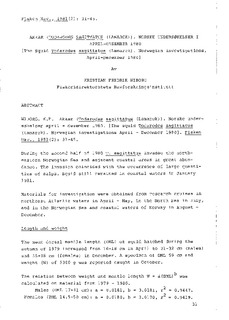| dc.description.abstract | During the second half of 1980 T. sagittatus invaded the northeastern
Norwegian Sea and adjacent coastal areas in great abundance.
The invasion coincided with the occurrence of large quantities
of salps. Squid still remained in coastal waters in January
1981.
Materials for investigation were obtained from research cruises in
northeast Atlantic waters in April - May, in the North Sea in July,
and in the Norwegian Sea and coastal waters of Norway in August -
December .
Length and weight.
The mean dorsal mantle length (DML) of squid hatched during the
autumn of 1979 increased from 16-18 cm in April to 31-32 cm (males)
and 35-38 cm (females) in December. A specimen of DML 59 cm and
weight (W) of 5300 g was reported caught in October.
The relation between weight and mantle length W = a(DML)b was
calculated on material from 1979 - 1980.
Males (DML 17-41 cm) : a = 0.0181, b = 3.0181, r2 = 0.9447.
Females (DML 14.5-50 cm): a = 0.0180, b = 3.0170, r2 = 0.9419.
Liver weight.
On the Porcupine Bank and at st. M in the Norwegian Sea the liver
averagely constituted about 7% of the total weight, in other areas
9-10%, with individual variations of 3.7 - 17.2%.
Sex proportions.
In fjords and coastal areas males constituted 0-10%, on the banks
about 13%, in oceanic areas 22-28%. The low proportion of males in
the fjords is ascribed to cannibalism.
Maturation.
In April - May, males with DML above 30 cm were maturing, most of
them with spermatophores developed. In October - November a few
large males had developing testes.
During July - December all females taken were immature. In April -
May about 50% of females with DML above 35 cm were maturing or
mature, with nidamental glands 50-100 mm in length. One female with
DML 44 cm had eggs (oocytes) in maturity stage 3. Total number in
the ovisac was calculated to 84 500, considerably above earlier
literature records.
Stomach contents.
As recorded earlier, fish were most common. Blue whiting, pearlside,
Notoscopelus krøyeri, Notolepis rissoi krøyeri, redfish,
herring or sprat and whiting were identified. Of squid, T. sagittatus,
Gonatus fabricii and small octopods were found. Of other organisms
krill and Hyperiids were most common. Pasiphaea sp., Pareuchaeta
sp., Nereis sp., Eukrohnia sp. were also identified.
Age.
A report on daily rings in the statoliths has been published. The
age readings revealed two main periods of hatching, September -
November and April - June, but reproduction also occurs at other
times of the year. Squid caught in October, are probably one year
or less of age, but the specimen with DML 59 cm might be 11/2 - 2
years old.
Fishery.
In 1980 the fishery yielded 2 500 m. tons. The possible yield was
estimated to 25-50 000 tons. | en |
